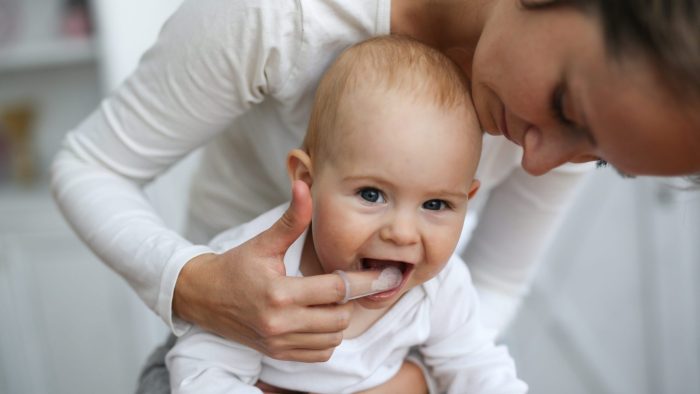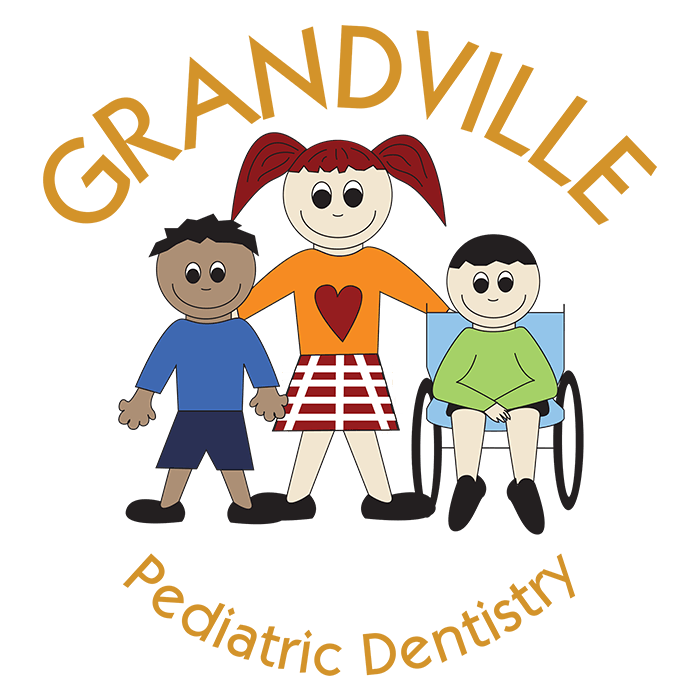How to “Brush” Before Teeth

There are a lot of things to worry about with a new baby. Feeding times, diaper changing, mandatory naps, and so on. It can feel overwhelming trying to keep up with it all. Because of everything there is to do, our Grandville, MI, pediatric dentists can understand why most parents don’t even consider oral care. However, just because babies aren’t born with teeth, doesn’t mean that their smiles aren’t still important.
Contrary to popular belief, oral hygiene can begin before teeth have emerged above the gum line. Now, it won’t be exactly like how you brush or floss your teeth and there won’t be any toothpaste involved yet. Until your child’s first tooth erupts, you’ll need to use other methods to gently keep their gummy smile clean.
Here’s our advice for and what you’ll need to use until teeth come in.
When to Start Caring for Your Child’s Mouth
Teeth don’t typically start to appear in your child’s mouth until they are between 6 and 12 months of age, although every child is different. While you’re waiting for the joy of seeing a little tooth poke through, there are .
Drs. Mike, Sally, and Agata recommend wiping their gums after each time they are fed or at least twice a day. Even though there are no teeth, bacteria can still grow and cling to gums if ignored. The plaque that’s left behind from the bacteria even has the potential to result in damaged primary teeth as they break through. Therefore, it’s so crucial to not let your child fall asleep while nursing or drinking a bottle of milk or juice as the sugars can sit in their mouth all night.
Read More → The Dangers of Baby Bottle Tooth Decay
Yes, can still make them susceptible to decay even if a bottle isn’t involved. This isn’t to say that you should stop breastfeeding before they’re ready. More so, it means that if you let your infant doze off as they’re nursing, the unswallowed milk in their mouth will coat their erupted teeth and make them vulnerable to cavity development. If you notice your baby starting to sleep, simply remove your breast and end the feeding session.
So, it might not seem like much, but wiping down your baby’s gums after meals and before bedtime can positively impact their oral health. These cleaning instances are also great opportunities to bond with your child.
Baby Oral Care Items You’ll Need
Your oral hygiene essentials in those early months of your child’s life will not include two key items: a toothbrush and toothpaste. The bristles of a toothbrush tend to be harsher than what a baby’s gums need so our pediatric dentists recommend a few options.
One approach is to use a soft, moistened cloth or piece of gauze for gentle cleaning your baby won’t get fussy about. You can also use a silicone finger slip toothbrush to move along the gums and fight bacterial growth. Your baby will likely love how the texture of the finger cover feels in their mouth which is a bonus.
As you start to notice , it’s important to keep using these simple materials for regular gum cleanings. Your baby will experience some discomfort before each tooth arrives so the act of massaging their gums will help to soothe them and alleviate any pain.
Brushing Once Teeth Erupt
When your little one finally has all or at least a few of their primary teeth showing, it’s ok to start integrating a small toothbrush and fluoride toothpaste into your routine with them. Generally speaking, this is after they’ve turned 1 but it can happen right after their first tooth appears. This period in their life is also a good time to bring them into our Grandville pediatric dental office for an infant oral health exam.
Brushing should happen at least twice a day, usually in the morning and before bed. If your child is less than thrilled, feel free to have some fun with their oral care. Try playing games while you brush, watching educational videos, or listening to songs about the importance of proper hygiene habits.
More Tips → 4 Ways to Make Brushing Teeth Fun
Not sure what type of brush is most appropriate for your child? Here is a guide on brush styles and corresponding ages:
- 0-3: silicone finger slip toothbrush once teeth begin to erupt. After age 1, parents can use a soft-bristled toothbrush with a small head
- 3-5: kid-sized toothbrush; typically, one with a larger handle
- 6-9: kid-sized toothbrush: one with a slimmer handle than those for toddlers
- 10+: adult sized toothbrush
Fluoride is perfectly safe for children but be sure to watch the amount of toothpaste given to your child. For kids under 3, only use a small smear of toothpaste that’s equal to a grain of rice. They should not graduate to a pea-sized amount until they are between 3 and 6 years old.
Remember if you’re unsure about anything, that we are here to help. Our pediatric dentists can help answer any questions you might have about brushing during scheduled dental exams and also offer fluoride treatment if you’re interested in this for your child.
Introduce Good Habits Early
It might seem silly at first to clean your baby’s gums before teeth, but by doing so, you’re setting them up for success down the road. Our , want you to know that the sooner your child gets in the rhythm of an oral care routine, the better their teeth will be. Call Grandville Pediatric Dentistry today at (616) 531-3430 to request an appointment.
This blog post has been updated.

